TOYOTA MIRAI 2023 Manual Online
Manufacturer: TOYOTA, Model Year: 2023, Model line: MIRAI, Model: TOYOTA MIRAI 2023Pages: 572, PDF Size: 17.71 MB
Page 81 of 572
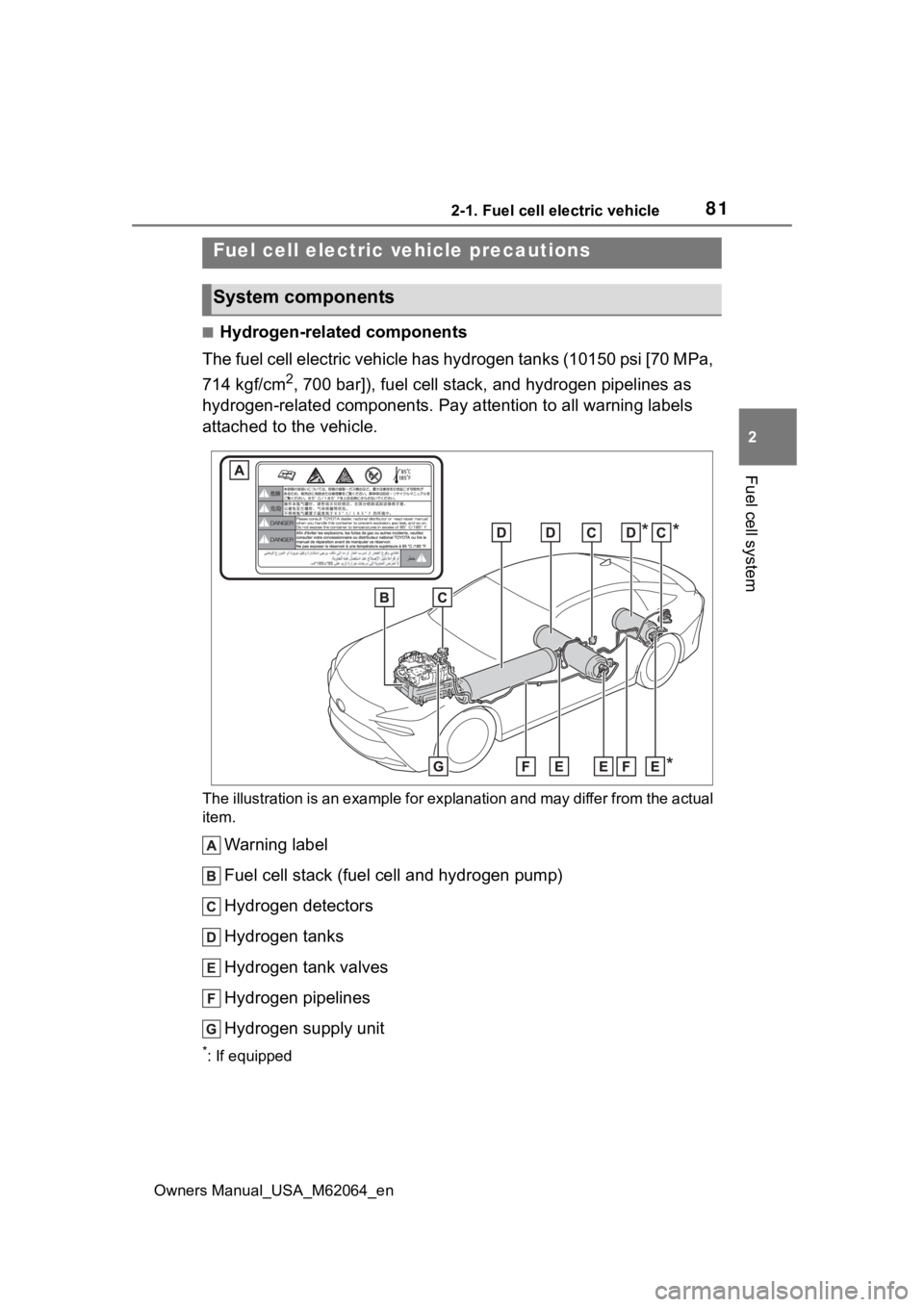
812-1. Fuel cell electric vehicle
Owners Manual_USA_M62064_en
2
Fuel cell system
■Hydrogen-related components
The fuel cell electric vehicle has hydrogen tanks (10150 psi [7 0 MPa,
714 kgf/cm
2, 700 bar]), fuel cell stack, and hydrogen pipelines as
hydrogen-related components. Pay attention to all warning label s
attached to the vehicle.
The illustration is an example fo r explanation and may differ from the actual
item.
Warning label
Fuel cell stack (fuel cell and hydrogen pump)
Hydrogen detectors
Hydrogen tanks
Hydrogen tank valves
Hydrogen pipelines
Hydrogen supply unit
*: If equipped
Fuel cell electric vehicle precautions
System components
Page 82 of 572
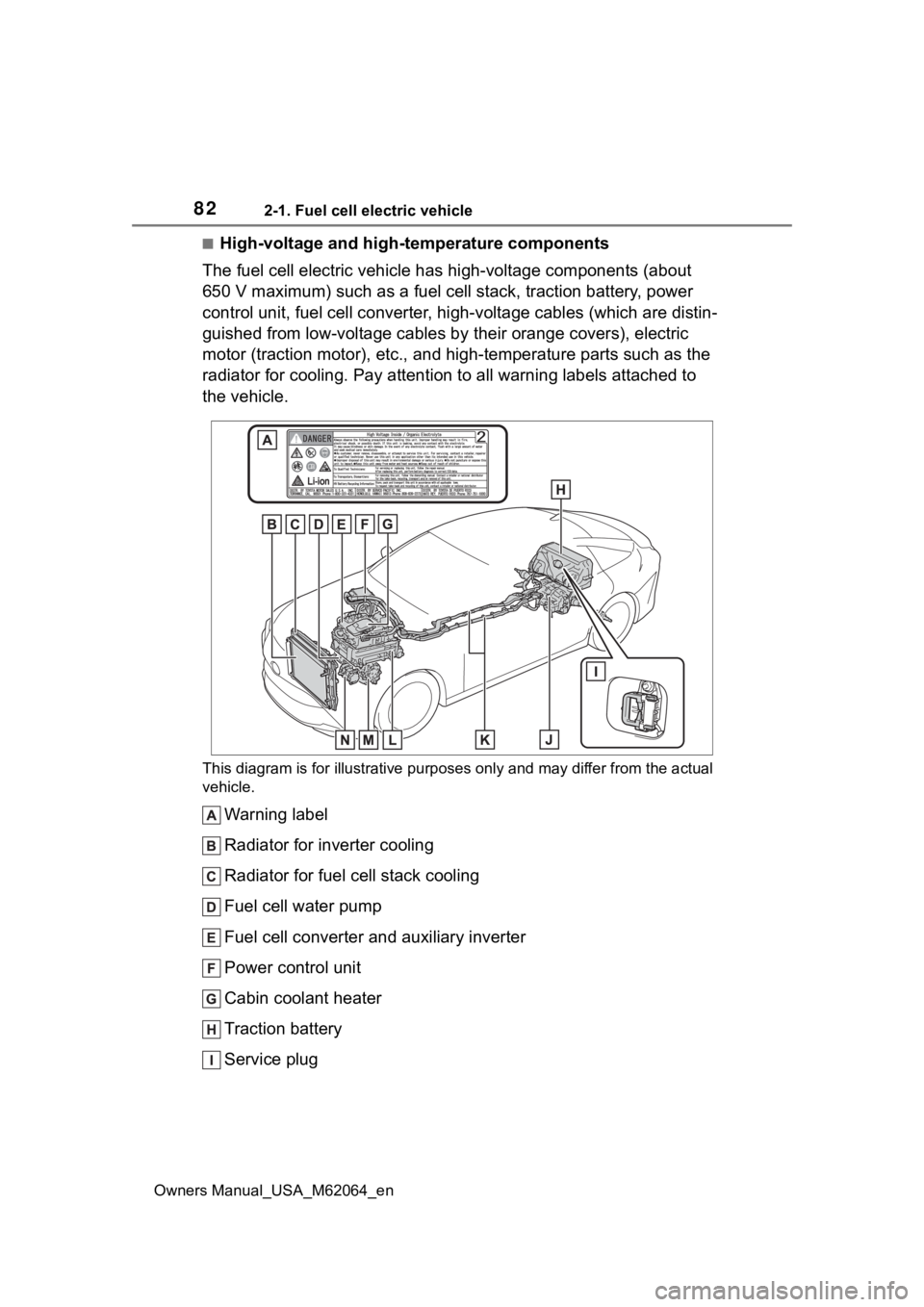
822-1. Fuel cell electric vehicle
Owners Manual_USA_M62064_en
■High-voltage and high-temperature components
The fuel cell electric vehicle has high-voltage components (abo ut
650 V maximum) such as a fuel c ell stack, traction battery, power
control unit, fuel cell converter, high-voltage cables (which a re distin-
guished from low-voltage cables b y their orange covers), electric
motor (traction motor), etc., and high-temperature parts such a s the
radiator for cooling. Pay attention to all warning labels attached to
the vehicle.
This diagram is for illustrative purposes only and may differ f rom the actual
vehicle.
Warning label
Radiator for inverter cooling
Radiator for fuel cell stack cooling
Fuel cell water pump
Fuel cell converter and auxiliary inverter
Power control unit
Cabin coolant heater
Traction battery
Service plug
Page 83 of 572
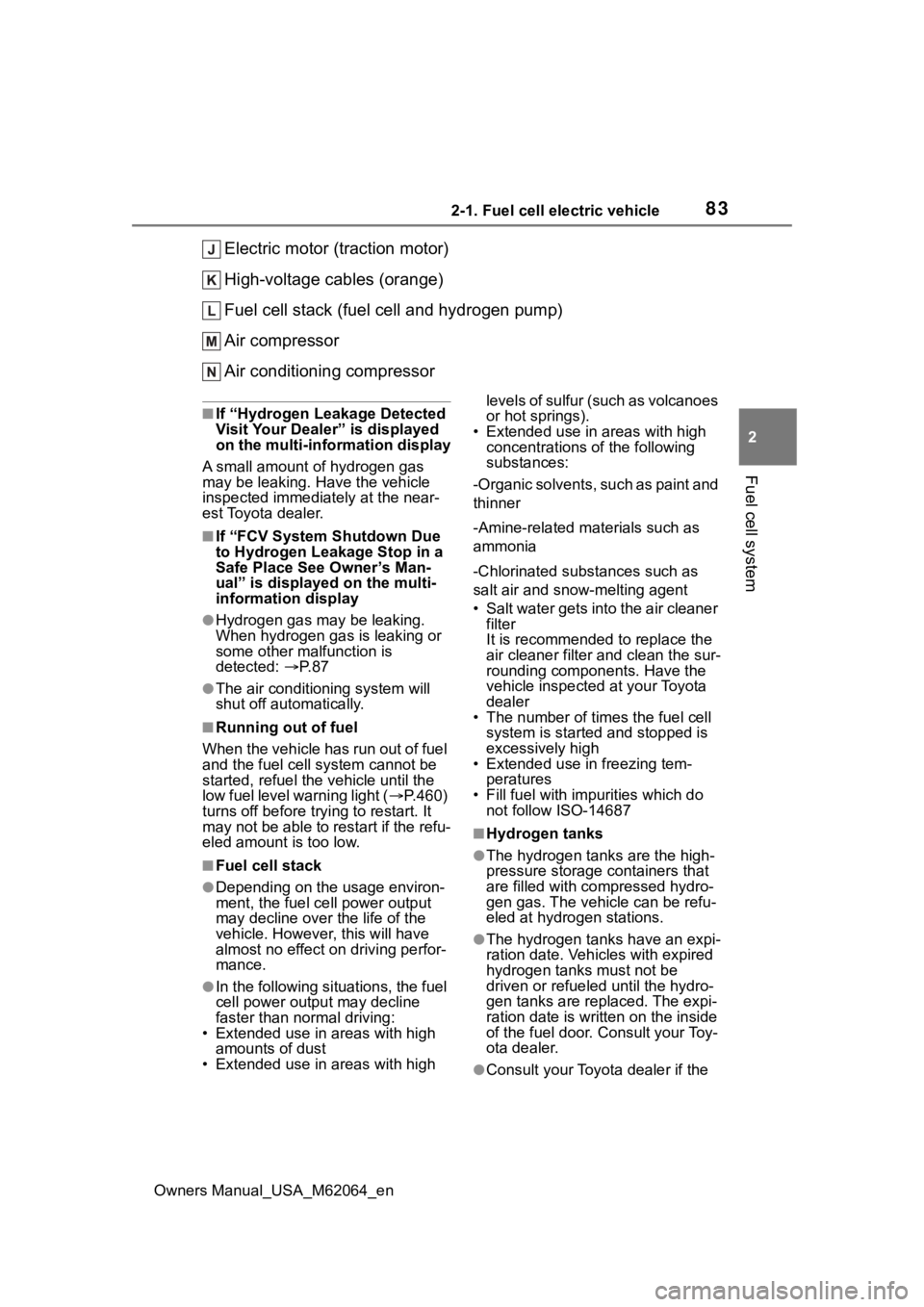
832-1. Fuel cell electric vehicle
Owners Manual_USA_M62064_en
2
Fuel cell system
Electric motor (traction motor)
High-voltage cables (orange)
Fuel cell stack (fuel cell and hydrogen pump)
Air compressor
Air conditioning compressor
■If “Hydrogen Leakage Detected
Visit Your Dealer” is displayed
on the multi-information display
A small amount of hydrogen gas
may be leaking. Have the vehicle
inspected immediately at the near-
est Toyota dealer.
■If “FCV System Shutdown Due
to Hydrogen Leakage Stop in a
Safe Place See Owner’s Man-
ual” is displayed on the multi-
information display
●Hydrogen gas may be leaking.
When hydrogen gas is leaking or
some other malfunction is
detected: P. 8 7
●The air conditioning system will
shut off automatically.
■Running out of fuel
When the vehicle has run out of fuel
and the fuel cell system cannot be
started, refuel the vehicle until the
low fuel level warning light ( P.460)
turns off before try ing to restart. It
may not be able to restart if the refu-
eled amount is too low.
■Fuel cell stack
●Depending on the usage environ-
ment, the fuel ce ll power output
may decline over the life of the
vehicle. However, this will have
almost no effect on driving perfor-
mance.
●In the following situations, the fuel
cell power output may decline
faster than normal driving:
• Extended use in areas with high
amounts of dust
• Extended use in areas with high levels of sulfur (such as volcanoes
or hot springs).
• Extended use in areas with high concentrations o f the following
substances:
-Organic solvents, such as paint and
thinner
-Amine-related materials such as
ammonia
-Chlorinated substances such as
salt air and snow-melting agent
• Salt water gets into the air cleaner filter
It is recommended to replace the
air cleaner filter and clean the sur-
rounding components. Have the
vehicle inspected at your Toyota
dealer
• The number of times the fuel cell system is started and stopped is
excessively high
• Extended use in freezing tem- peratures
• Fill fuel with impurities which do not follow ISO-14687
■Hydrogen tanks
●The hydrogen tanks are the high-
pressure storage containers that
are filled with co mpressed hydro-
gen gas. The vehicle can be refu-
eled at hydrogen stations.
●The hydrogen tanks have an expi-
ration date. Vehicles with expired
hydrogen tanks must not be
driven or refueled until the hydro-
gen tanks are replaced. The expi-
ration date is written on the inside
of the fuel door. Consult your Toy-
ota dealer.
●Consult your Toyota dealer if the
Page 84 of 572

842-1. Fuel cell electric vehicle
Owners Manual_USA_M62064_enhydrogen tanks or valves need to
be disposed.
■Fuel cell stack coolant
●Fuel cell stack coolant uses a spe-
cifically-designed fluid with high
electrical insulation properties, in
order to safely cool the high-volt-
age fuel cell stack.
●Never add water or other coolants
to the fuel cell st
ack cooling sys-
tem, as they will cause permanent
damage.
●Consult your Toyota dealer for
replenishing or changing the fuel
cell stack coolant.
■Ion filter
●An ion filter is inst alled in the cool-
ant lines for the fuel cell stack, in
order to maintain the normal insu-
lation properties of the coolant.
●It is necessary to periodically
change the ion filter. ( P.466)
Contact your Toyota dealer for this
periodic maintenance.
■Tailpipe
●When the power switch is turned
off and the fuel cell system is
stopped ( P.182) after driving,
exhaust water is discharged. Be
careful when standing behind the
vehicle to avoid dripping or spray-
ing.
●It is possible to manually purge
the exhaust. Thi s may be desir-
able, for instance, before parking
in a garage. This is done by press-
ing the H
2O switch. ( P.196)
●On cold days, water vapor in the
exhaust may appe ar as a white
mist emitted from the tailpipe. This
is not a malfunction. A white mist
may be emitted from the vehicle
side depending on the wind direc-
tion. If it is a concern, consult with
a Toyota dealer.
●If the tailpipe is blocked, the fuel
cell system will stop.
●In the following state when cold, a white mist may be emitted. Water
vapor is being emitted as a sys-
tem protection and it is not a mal-
function.
• If several minutes have passed after opening the fuel lid, such as
refueling.
• Several hours have passed after the power switch was turned off.
■Hydrogen detectors
When the power switch is turned to
ON, the hydrogen detectors are
activated.
■Power output restriction
When the power output is restricted,
the vehicle may fa il to accelerate or
even decelerate, even though the
accelerator pedal is depressed. If a
safe driving speed cannot be main-
tained, stop the ve hicle in a safe
place away from the traffic. This
may be caused by the following con-
ditions:
●The coolant temperature may be
too high. This can be caused by
driving conditions such as
repeated sudden acceleration and
deceleration, continuous driving
on an incline, continuous driving
at high altitudes with a high load,
etc. In such situations, “FCV sys-
tem overheated Output power
reduced” is displayed on the multi-
information display, and the power
output is restricted. Once the cool-
ant returns to normal temperature,
the power output will retu rn to nor-
mal. ( P.464)
●The remaining fuel may be low.
After the low fuel level warning
light comes on, the output power
will be gradually restricted in order
to extend the possible driving dis-
tance. Once getting to this point,
the remaining driving distance
possible is short. Immediately refill
the vehicle with hydrogen.
●On cold days, the low fuel level
warning light comes on faster than
usual and the output power is
restricted.
Page 85 of 572

852-1. Fuel cell electric vehicle
Owners Manual_USA_M62064_en
2
Fuel cell system
■Electromagnetic waves (EMF)
●High-voltage parts and cables in
fuel cell electric vehicles have an
electromagnetic shielding configu-
ration, and therefore emit approxi-
mately the same amount of
electromagnetic waves as con-
ventional gasoli ne-powered vehi-
cles or home electronic
appliances.
●Your vehicle may cause sound
interference in so me third party-
produced radio parts.
■Starting the fuel cell system in
an extremely col d environment
When the tracti on battery is extremely cold (below approxi-
mately -22˚F [-30˚C]) under the
influence of outsi
de temperature, it
may not be possible to start the fuel
cell system. In this case, try to start
the fuel cell system again after the
temperature of the traction battery
increases due to the outside tem-
perature increase etc.
■Traction battery
The traction battery has a limited
service life. The lifespan of the trac-
tion battery can change according to
driving style and driving conditions.
■Hydrogen Gas Characteristics
●Hydrogen gas ignites more easily than gasoline, however it is l ight than air
and disperses quickly. The hydrogen system and tank sufficientl y serve as
a counter-measure to prevent gas leaks. However, if by chance there is a
gas leak, the hydrogen gas is rapidly diluted until it is no lo nger flammable.
●As with gasoline and natural gas, hydrogen gas is not dangerous if it is
handled properly. Thoroughly rea d and understand the characteristics
shown in the table below.
Hydrogen gasLPG (Liquid
Petroleum Gas)Gasoline
Normal stateGaseous (Lighter
than air)Gaseous
(Heavier than air)
Volatile liquid
(evaporates eas-
ily) (Heavier than
air)
Ease of ignitionEasier than gaso-
lineAt the same level
as gasoline—
Page 86 of 572
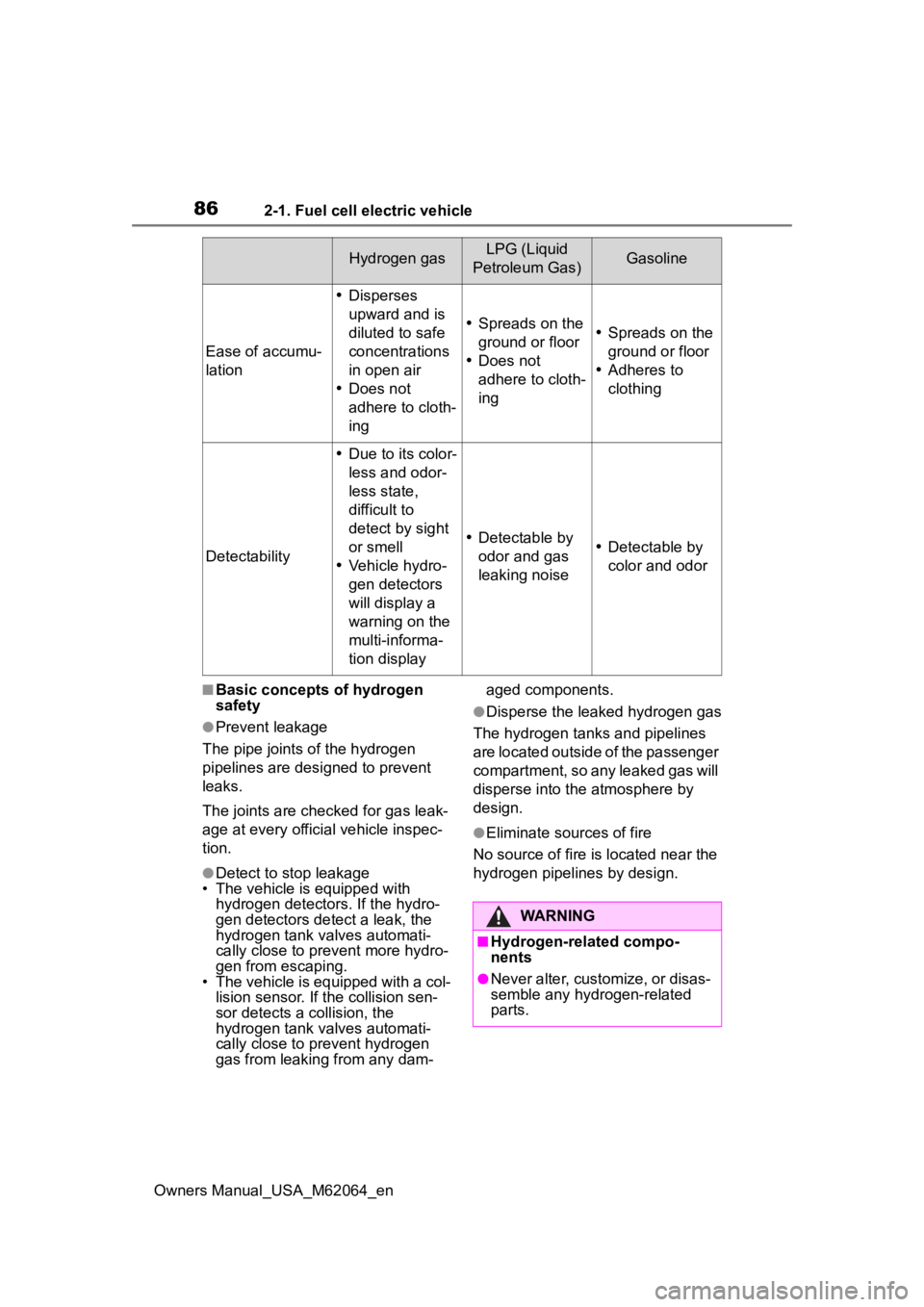
862-1. Fuel cell electric vehicle
Owners Manual_USA_M62064_en
■Basic concepts of hydrogen
safety
●Prevent leakage
The pipe joints o f the hydrogen
pipelines are designed to prevent
leaks.
The joints are checked for gas leak-
age at every official vehicle inspec-
tion.
●Detect to stop leakage
• The vehicle is equipped with
hydrogen detectors. If the hydro-
gen detectors detect a leak, the
hydrogen tank valves automati-
cally close to prevent more hydro-
gen from escaping.
• The vehicle is equipped with a col- lision sensor. If the collision sen-
sor detects a collision, the
hydrogen tank valves automati-
cally close to prevent hydrogen
gas from leaking from any dam- aged components.
●Disperse the leaked hydrogen gas
The hydrogen tanks and pipelines
are located outside of the passenger
compartment, so any leaked gas will
disperse into the atmosphere by
design.
●Eliminate sources of fire
No source of fire is located near the
hydrogen pipelines by design.
Ease of accumu-
lation
Disperses
upward and is
diluted to safe
concentrations
in open air
Does not
adhere to cloth-
ing
Spreads on the
ground or floor
Does not
adhere to cloth-
ingSpreads on the
ground or floor
Adheres to
clothing
Detectability
Due to its color-
less and odor-
less state,
difficult to
detect by sight
or smell
Vehicle hydro-
gen detectors
will display a
warning on the
multi-informa-
tion display
Detectable by
odor and gas
leaking noiseDetectable by
color and odor
Hydrogen gasLPG (Liquid
Petroleum Gas)Gasoline
WARNING
■Hydrogen-related compo-
nents
●Never alter, customize, or disas-
semble any hydrogen-related
parts.
Page 87 of 572
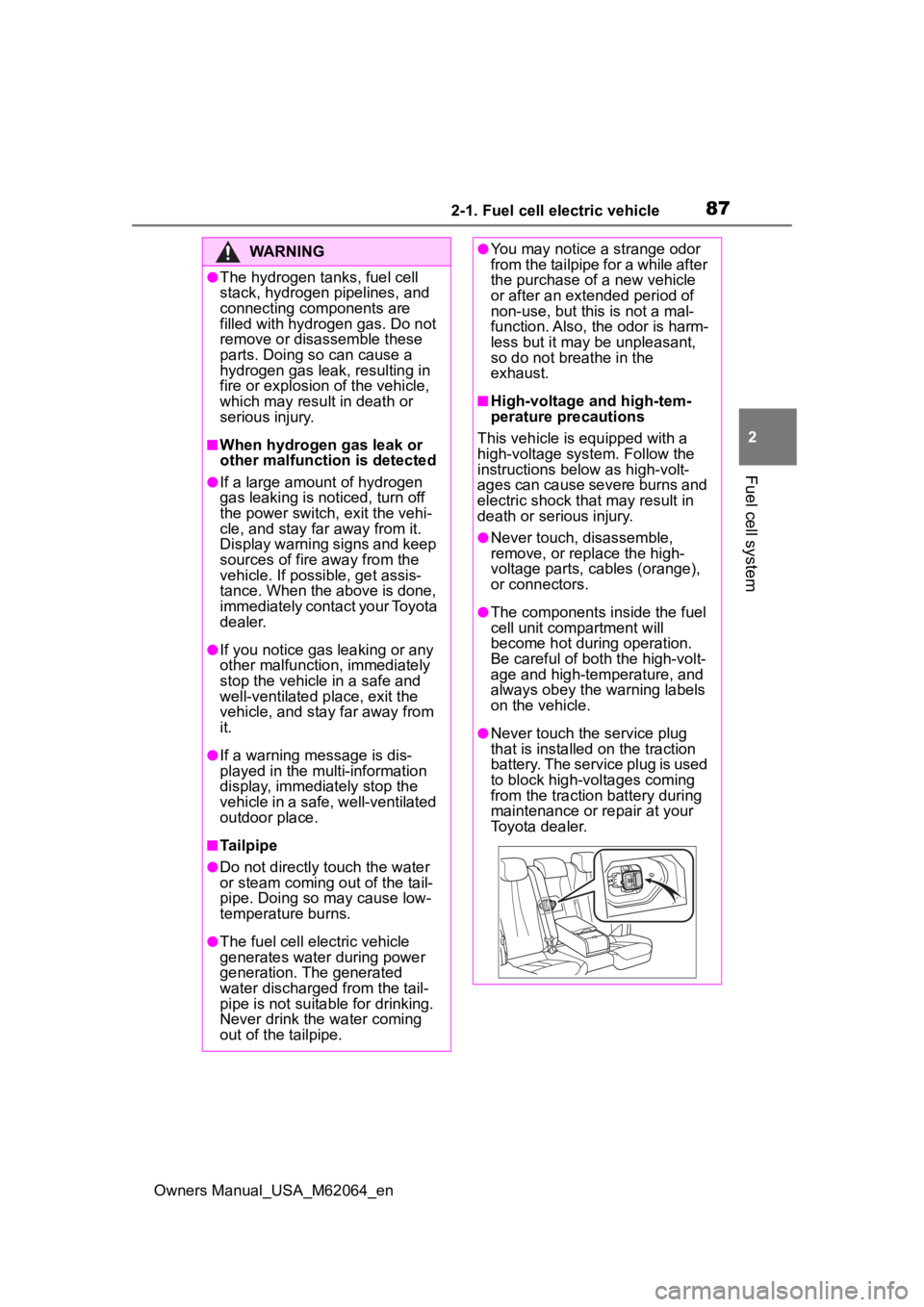
872-1. Fuel cell electric vehicle
Owners Manual_USA_M62064_en
2
Fuel cell system
WARNING
●The hydrogen tanks, fuel cell
stack, hydrogen pipelines, and
connecting components are
filled with hydrogen gas. Do not
remove or disassemble these
parts. Doing so can cause a
hydrogen gas leak, resulting in
fire or explosion of the vehicle,
which may result in death or
serious injury.
■When hydrogen gas leak or
other malfunctio n is detected
●If a large amount of hydrogen
gas leaking is noticed, turn off
the power switch, exit the vehi-
cle, and stay far away from it.
Display warning signs and keep
sources of fire away from the
vehicle. If possible, get assis-
tance. When the above is done,
immediately contact your Toyota
dealer.
●If you notice gas leaking or any
other malfunction, immediately
stop the vehicle in a safe and
well-ventilated place, exit the
vehicle, and stay far away from
it.
●If a warning message is dis-
played in the multi-information
display, immediately stop the
vehicle in a safe, well-ventilated
outdoor place.
■Tailpipe
●Do not directly touch the water
or steam coming out of the tail-
pipe. Doing so may cause low-
temperature burns.
●The fuel cell electric vehicle
generates water during power
generation. The generated
water discharged from the tail-
pipe is not suitable for drinking.
Never drink the water coming
out of the tailpipe.
●You may notice a strange odor
from the tailpipe for a while after
the purchase of a new vehicle
or after an extended period of
non-use, but this is not a mal-
function. Also, the odor is harm-
less but it may be unpleasant,
so do not breathe in the
exhaust.
■High-voltage and high-tem-
perature precautions
This vehicle is equipped with a
high-voltage system. Follow the
instructions below as high-volt-
ages can cause severe burns and
electric shock that may result in
death or serious injury.
●Never touch, disassemble,
remove, or replace the high-
voltage parts, cables (orange),
or connectors.
●The components inside the fuel
cell unit compartment will
become hot during operation.
Be careful of both the high-volt-
age and high-temperature, and
always obey the warning labels
on the vehicle.
●Never touch the service plug
that is installed on the traction
battery. The service plug is used
to block high-voltages coming
from the traction battery during
maintenance or repair at your
Toyota dealer.
Page 88 of 572
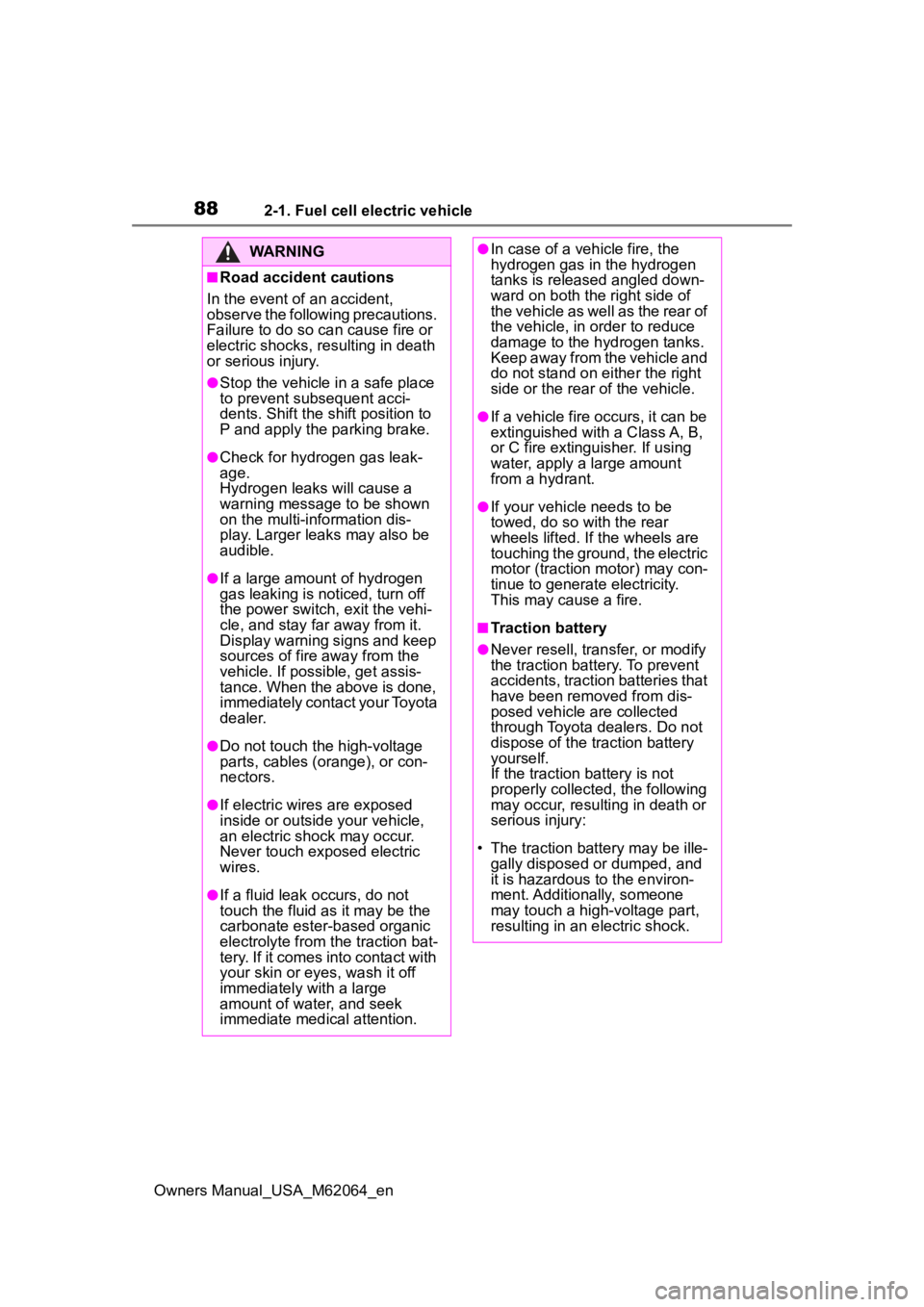
882-1. Fuel cell electric vehicle
Owners Manual_USA_M62064_en
WARNING
■Road accident cautions
In the event of an accident,
observe the following precautions.
Failure to do so c an cause fire or
electric shocks, resulting in death
or serious injury.
●Stop the vehicle i n a safe place
to prevent subsequent acci-
dents. Shift the shift position to
P and apply the parking brake.
●Check for hydrogen gas leak-
age.
Hydrogen leaks will cause a
warning message to be shown
on the multi-information dis-
play. Larger leaks may also be
audible.
●If a large amount of hydrogen
gas leaking is noticed, turn off
the power switch, exit the vehi-
cle, and stay far away from it.
Display warning signs and keep
sources of fire away from the
vehicle. If possible, get assis-
tance. When the above is done,
immediately contact your Toyota
dealer.
●Do not touch the high-voltage
parts, cables (orange), or con-
nectors.
●If electric wires are exposed
inside or outside your vehicle,
an electric shock may occur.
Never touch exposed electric
wires.
●If a fluid leak occurs, do not
touch the fluid as it may be the
carbonate ester-based organic
electrolyte from t he traction bat-
tery. If it comes into contact with
your skin or eyes, wash it off
immediately with a large
amount of water, and seek
immediate medical attention.
●In case of a vehicle fire, the
hydrogen gas in the hydrogen
tanks is released angled down-
ward on both the right side of
the vehicle as well as the rear of
the vehicle, in order to reduce
damage to the hydrogen tanks.
Keep away from the vehicle and
do not stand on either the right
side or the rear of the vehicle.
●If a vehicle fire occurs, it can be
extinguished with a Class A, B,
or C fire extinguisher. If using
water, apply a large amount
from a hydrant.
●If your vehicle needs to be
towed, do so with the rear
wheels lifted. If the wheels are
touching the ground, the electric
motor (traction motor) may con-
tinue to generate electricity.
This may cause a fire.
■Traction battery
●Never resell, trans fer, or modify
the traction batte ry. To prevent
accidents, traction batteries that
have been removed from dis-
posed vehicle are collected
through Toyota dealers. Do not
dispose of the traction battery
yourself.
If the traction battery is not
properly collected, the following
may occur, resulting in death or
serious injury:
• The traction battery may be ille- gally disposed or dumped, and
it is hazardous to the environ-
ment. Additionally, someone
may touch a high-voltage part,
resulting in an electric shock.
Page 89 of 572
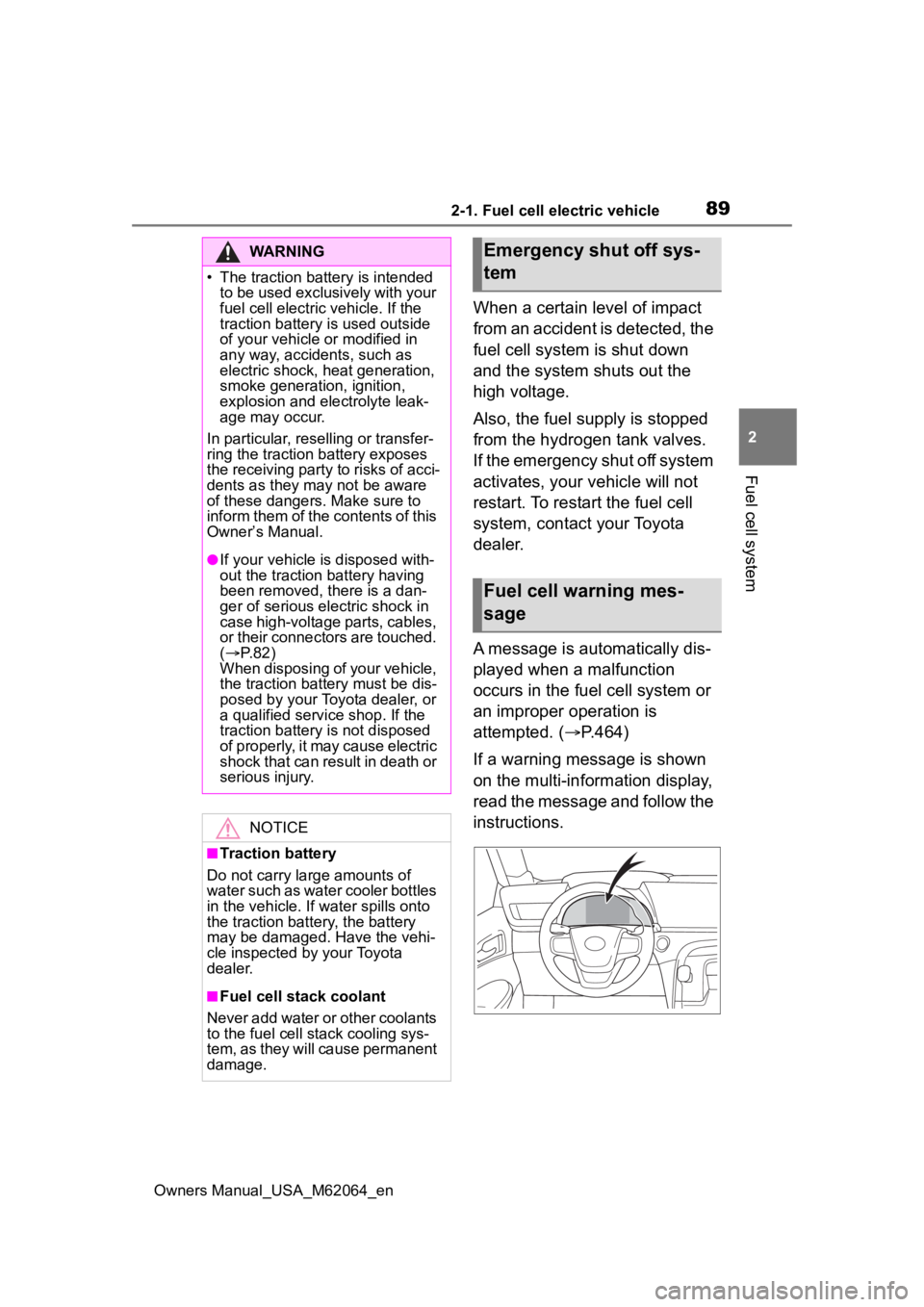
892-1. Fuel cell electric vehicle
Owners Manual_USA_M62064_en
2
Fuel cell system
When a certain level of impact
from an accident is detected, the
fuel cell system is shut down
and the system shuts out the
high voltage.
Also, the fuel supply is stopped
from the hydrogen tank valves.
If the emergency shut off system
activates, your vehicle will not
restart. To restart the fuel cell
system, contact your Toyota
dealer.
A message is automatically dis-
played when a malfunction
occurs in the fuel cell system or
an improper operation is
attempted. ( P.464)
If a warning message is shown
on the multi-information display,
read the message and follow the
instructions.
WARNING
�
Page 90 of 572
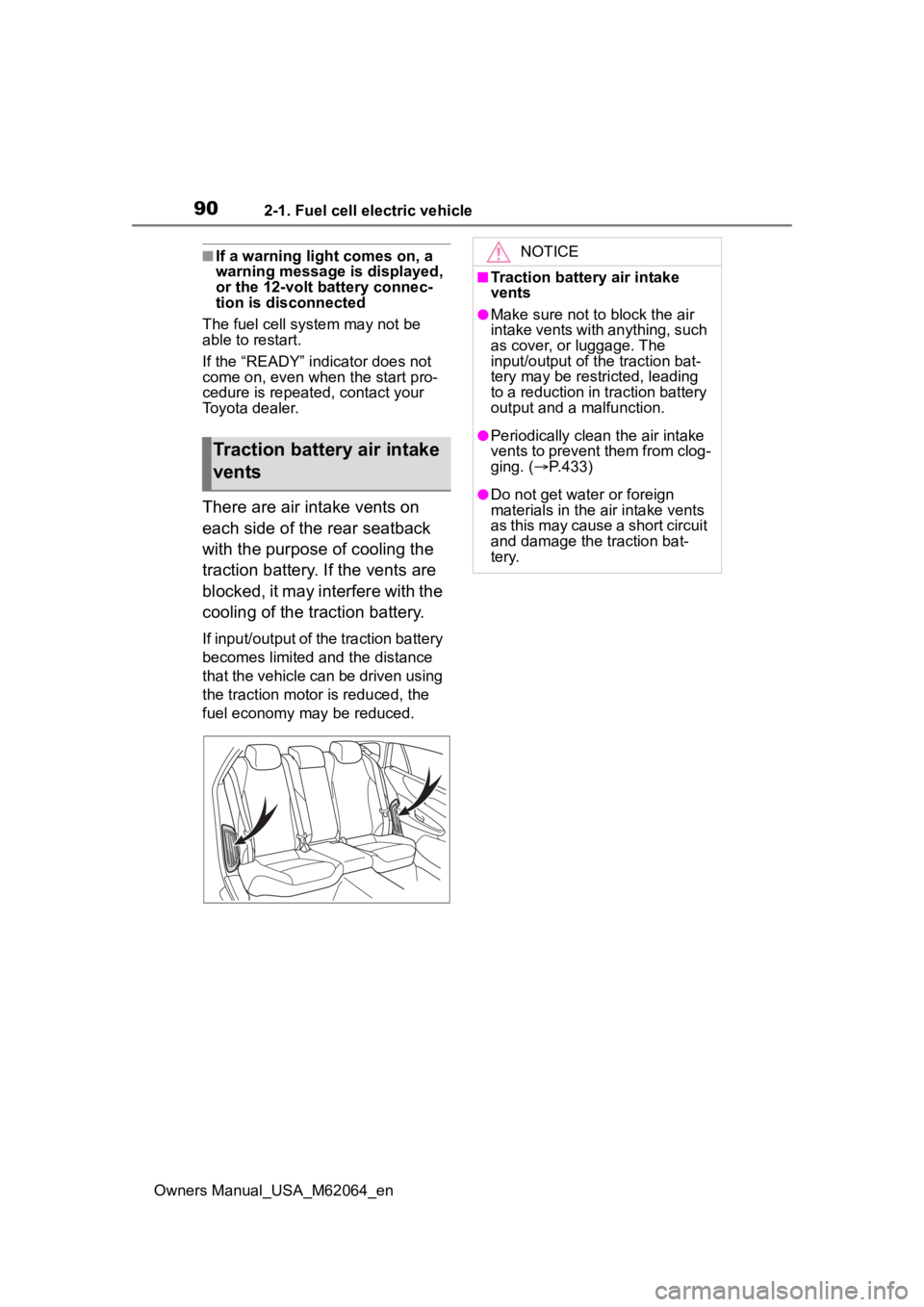
902-1. Fuel cell electric vehicle
Owners Manual_USA_M62064_en
■If a warning light comes on, a
warning message is displayed,
or the 12-volt battery connec-
tion is disconnected
The fuel cell system may not be
able to restart.
If the “READY” indicator does not
come on, even when the start pro-
cedure is repeated, contact your
Toyota dealer.
There are air intake vents on
each side of the rear seatback
with the purpose of cooling the
traction battery. If the vents are
blocked, it may interfere with the
cooling of the traction battery.
If input/output of the traction battery
becomes limited and the distance
that the vehicle can be driven using
the traction motor is reduced, the
fuel economy may be reduced.
Traction battery air intake
vents
NOTICE
■Traction battery air intake
vents
●Make sure not to block the air
intake vents with anything, such
as cover, or luggage. The
input/output of t he traction bat-
tery may be restricted, leading
to a reduction in traction battery
output and a malfunction.
●Periodically clean the air intake
vents to prevent them from clog-
ging. ( P.433)
●Do not get water or foreign
materials in the air intake vents
as this may cause a short circuit
and damage the traction bat-
tery.